With naturally high body temperatures and no sweat glands, birds adjust to hot weather by using a method that requires more energy than sweating. They begin panting when they need to release their body heat.
To help geese cool down fast and efficiently on hot days, it is vital to provide them with the proper resources.
Geese are waterfowl, so it shouldn’t be surprising that they need more than just a steady supply of drinking water during the summer.
The easiest way to keep geese cool is to provide a place to swim or simply float on the refreshing water.
Keep reading to find out what you can do to ensure that summer is a joyous season rather than a sweltering misery for your geese.
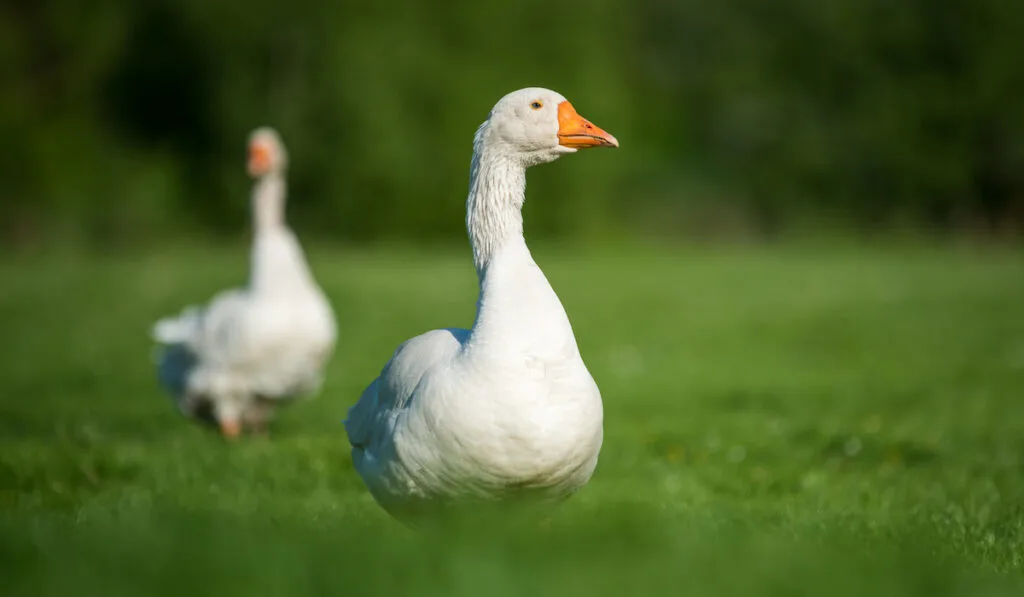
Table of Contents
How Do Geese Keep Their Body Temperatures Down?
Geese lose most of their body heat through panting, the bare skin on their legs and feet, and by fluffing up their feathers and spreading their wings to increase the surface area and speed up the rate of heat loss.
Overheating Symptoms in Geese
- Panting, gaping mouth breathing
- Separating their wings from their bodies
- Drinking more water than usual
- Eating less than usual
- Smaller egg sizes
- The ability to produce eggs is decreased
- Delicate, papery eggshells
- Acting as though they are under stress
- Being weak in body
- Drooping
- Lethargic
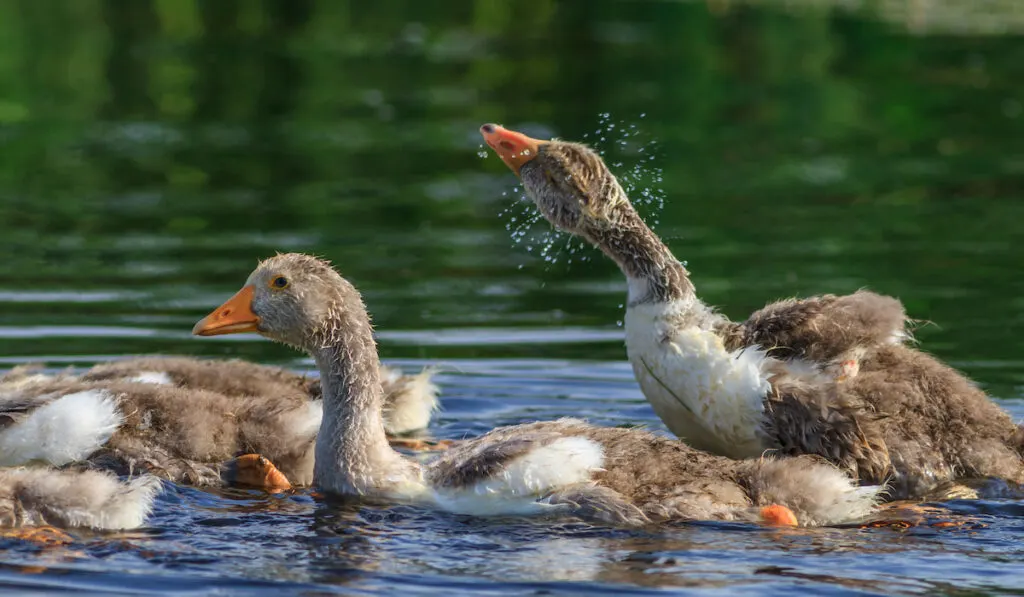
First aid
Overheating is a severe risk for your geese, so if you notice any heat distress signs, get them out of the sun immediately.
Misting or soaking your bird in chilly water will help it cool down. But be careful because ice-cold water can give your geese a cold shock.
If your animal’s health is at risk, always contact your veterinarian for professional assistance.
When Is the Heat Dangerous for Geese?
Geese prefer mild temperatures between 40 and 75°F (4.4 and 23.8°C). While the heat alone is bad for your geese, the combination of high heat and high humidity poses the greatest threat to their well-being.
Poultry starts to experience heat stress when the temperature outside rises beyond 80°F (26.6°C), and it becomes dangerous at roughly 85°F (29.4°C).
So, once the temperature reaches between 75 and 80°F (23.8 and 26.6°C), you should start providing more active support for your geese to withstand the heat.
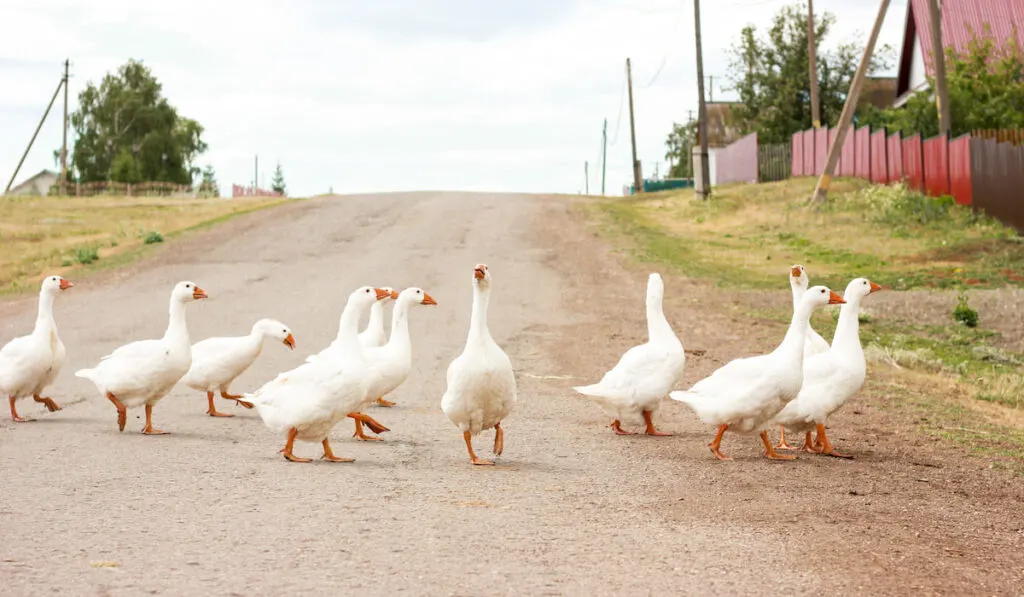
The Effects of High Temperatures on Geese
Temperatures ranging from 65° and 75°F (18°and 24°C)
- The optimal temperature for your geese
- There is no need for additional support
- Basic care
Temperatures ranging from 75° to 85°F (24° to 29°C)
- Feed consumption may decline slightly
- Eggs may shrink, and shells may weaken when temperatures hit the top of this range
Temperatures ranging from 85° to 90°F (29° to 32°C)
- Feed consumption falls further
- Egg production decreases, and the size of eggs and the quality of shells becomes worse
- When the temperature hits this level, it’s time to start providing extra care for your geese so they can stay comfortable
Temperatures ranging from 90° to 95°F (32° to 35°C)
- Laying hens, older or larger birds, and those with health problems are particularly vulnerable
- At these temperatures, cooling measures are required
Over 95°F (35°C)
- Temperatures of 100°F (37.7°C) or above can be deadly for birds
- You should provide every possible aid to your birds to cool down
- Be prepared to provide first aid in cases of heat stroke
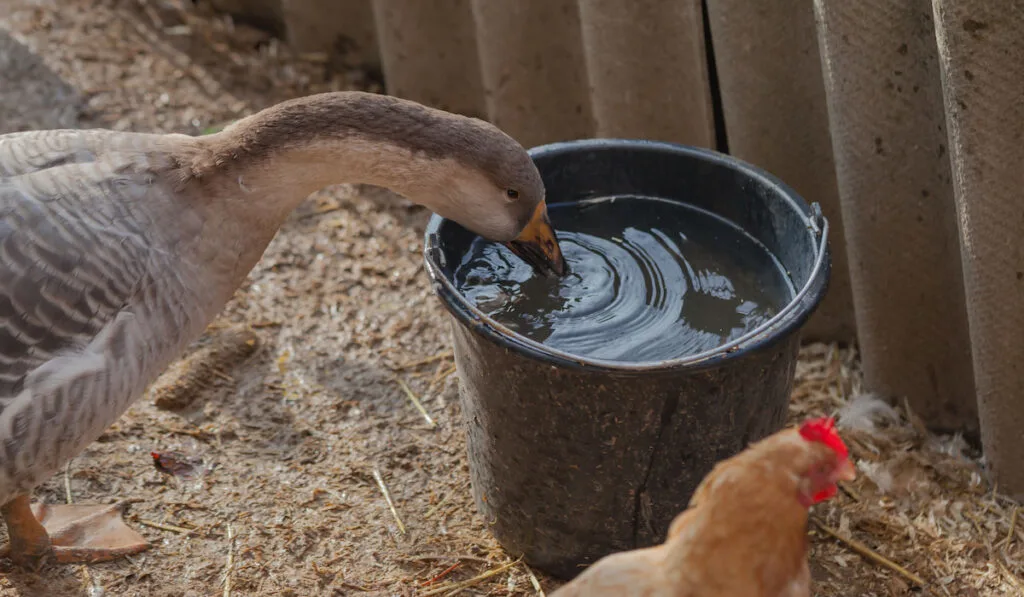
10 Tips to Help Geese Stay Cool
1. FreshWater
Geese require water to avoid overheating during the day.
Make sure your birds always have access to clean water provided from multiple sources. That way, if one container gets knocked over or contaminated, there will still be others.
Changing their water regularly is a necessary requirement. It is good to replace your birds’ water at least three times daily to keep it cool and clean.
2. Keep Water Cold for Longer
To keep your birds’ water cooler for longer on a hot day, choose a container with a greater depth.
When you do, the water temperature will not rise as quickly as when you use a container with shallow depth.
To extend the water’s coolness, add some ice cubes. If you’re using large troughs for water, you can keep the temperature down by placing frozen water bottles inside.
3. Swimming Spots
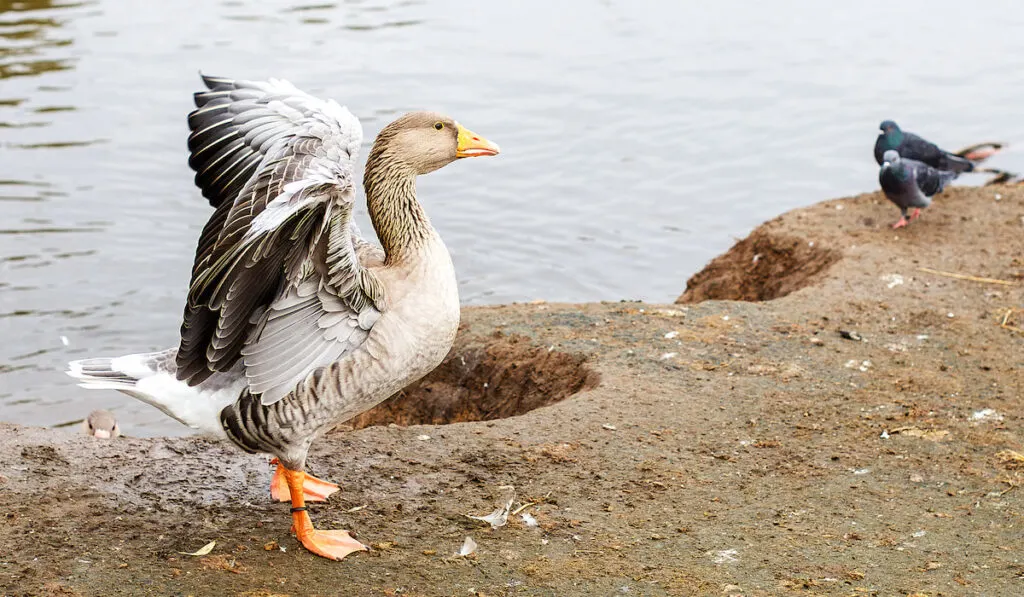
Although a pond is ideal for your flock, you may want to explore alternative ways to give them access to the water they so much crave.
Place some plastic kiddie pools, a big water trough, a garden tub, or a large basin for the geese to enjoy a refreshing bath.
However, all those swimming choices will quickly get dirty, and algae can become a concern in hot, sunny weather. To reduce the danger of disease, they should be thoroughly cleaned each day and refilled with new water.
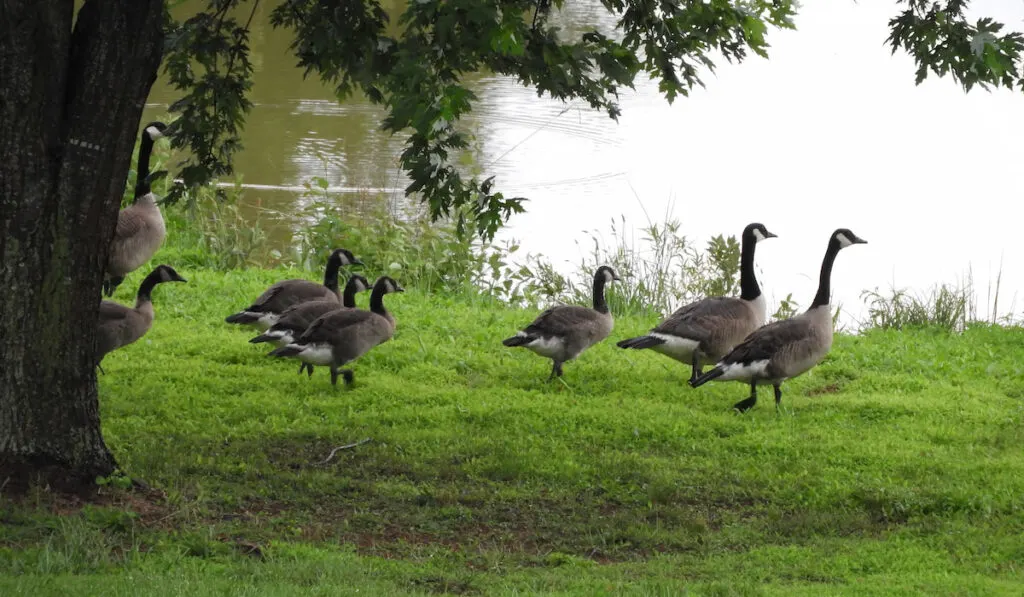
4. Shady Spots
Shaded places (natural or artificial) large enough to house the whole flock should be available to your geese at all times of the day.
The geese can find shelter in the shade of trees and plants, but you can also create artificially shady spots.
A shady spot may be created in a matter of hours, and you don’t even need to be a DIY expert. It’s as simple as hanging some thicker fabric over some posts, and you’re done!
5. Sprinklers
Installing a sprinkler in the enclosure will keep the geese entertained and reduce the temperature of the surrounding air and ground temperature as well.
Nothing beats a sprinkler for quick relief from the heat. They can bring the temperature down by as much as 30 degrees in a matter of minutes!
Suppose the forecast calls for temperatures of 75°F (24°C) or higher, especially around the middle of the day when the sun is at its warmest. In that case, I recommend leaving the sprinklers on for an additional hour or so.
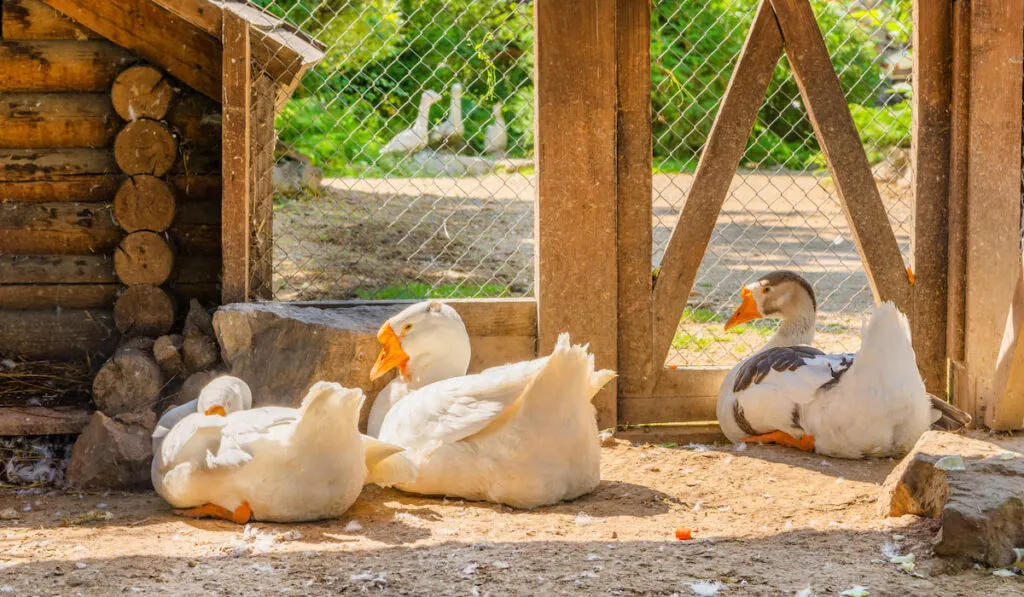
6. Coop Ventilation
Having well-ventilated housing for your geese is key to their health and well-being. A temperature of 80°F (27°C) or above is dangerous for poultry. Therefore, keeping the coop well-ventilated throughout the hot summer months is important.
About one-fifth of your coop’s wall space should be given to windows and ventilation as a general guideline.
However, if your coop lacks adequate ventilation or you live in a hot climate, a fan may be required to ensure adequate air circulation.
In most cases, a fan that can generate five cubic feet per minute of air per goose in the coop will be sufficient.
7. Avoid Being Too Crowded
Even without hot weather, the heat produced by many geese in enclosed spaces is enough to create heat stress, which can be deadly. When many geese are concentrated in a limited area, their combined body heat makes each goose’s temperature soar.
Depending on the breed of geese you have, it is recommended that you provide 6–8 square feet of coop area for each bird to ensure that they have enough room to wander and nest.
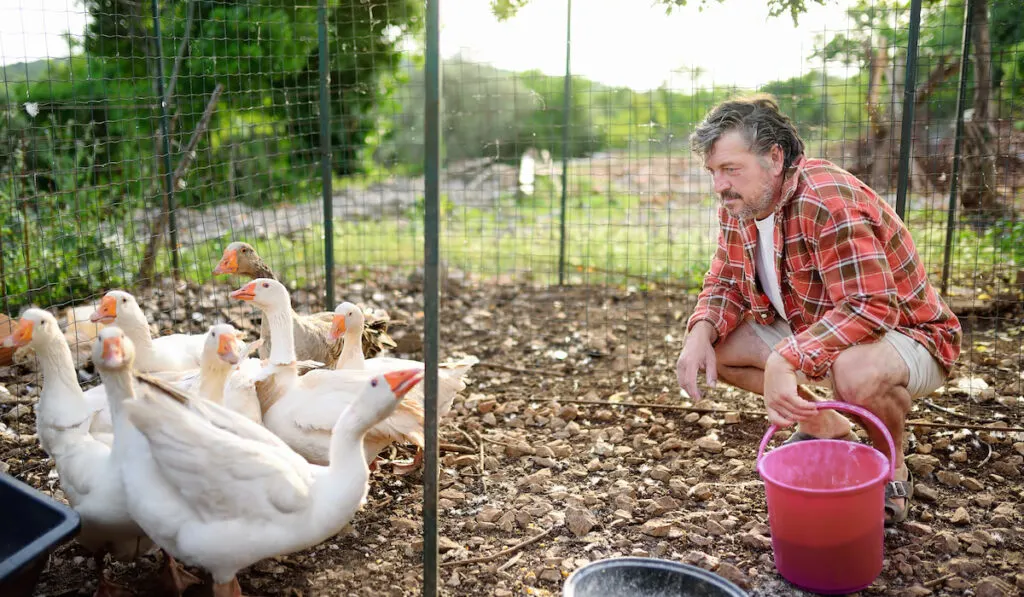
8. Light Green Diet
When a bird’s digestive system is working, it produces heat.
Foods that are hard to digest, like fats and proteins, make digestion take longer and more intense, raising the bird’s body temperature.
As a result, high-calorie products should be the core of the diet in the winter, while in warmer weather, the diet should be different.
Feed your geese a fiber-rich food that is not digested or absorbed in the digestive tract. Green leafy foods, as well as raw fruits and vegetables, are high in fiber. Additionally, the high-water content of fruits aids in keeping your geese hydrated.
9. Cool, Frozen Treats
If you cut up some fruits, vegetables, or herbs and freeze them for a few hours, you will have nutritious and delicious snacks in no time!
You can scatter frozen treats throughout the aviary or put them in water bowls for extra fun and cooler temperatures for your flock of geese.
Goose favorites are:
- Watermelon
- Grapes
- Blueberry and raspberry
- Cucumber
- Cabbage
- Squash and pumpkin
- Swiss chard
- Brussels sprouts
- Spinach
- Kale
10. Electrolyte Supplements
When the temperature goes up, birds breathe faster to cool down, but this causes them to lose a lot of electrolytes, like potassium and sodium.
Sodium and potassium are related and need each other. They are the two main electrolytes that help control the balance of fluids, muscle contractions, and nerve signals.
You may want to feed your birds electrolytes as a preventative measure if high temperatures and high humidity have been forecasted.
Potassium is found in vegetables and fruits such as spinach and kale, as well as grapes, peas, and blackberries. However, you can also use a commercially produced electrolyte supplement or easily make your own.
You can purchase the following electrolytes for poultry:
- Avian Electrolytes
- Vet Qingdao Animal Health, SupraPlus©
- PlusVet Qingdao Animal Health, PhytoShield©
- Sav-A-Chick, Vitamins & Electrolytes
- Durvet, Vitamins, and Electrolytes for Poultry
Self-made electrolyte recipe:
One gallon of warm water should be mixed with the following:
- 1 teaspoon white sugar
- 1 teaspoon baking soda.
- 1 teaspoon of salt.
When using electrolytes, it is important to follow the package instructions and consult your veterinarian before using any homemade alternatives.
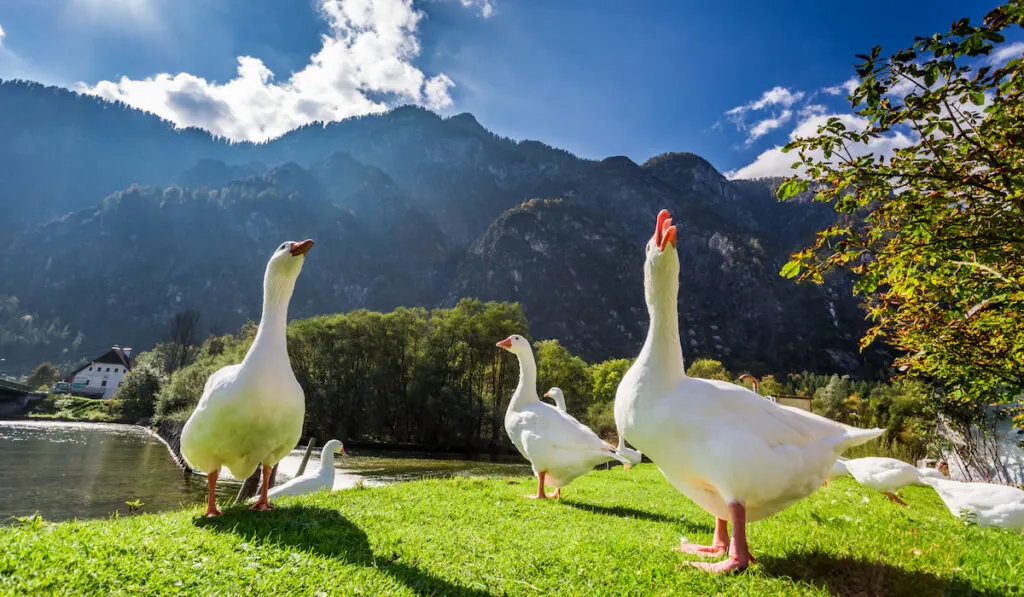
Final Thoughts
When summer arrives, and temperatures rise, you should be prepared to provide the best care for your geese. Because it’s getting hotter every year, it’s wise to have all the knowledge needed to keep your geese cool in the summer.
Heat stress can be harmful and even fatal to geese if it is not prevented or treated in a timely manner. So, remember the basic needs of your geese during the hot summer months.
First, guarantee that your birds always have access to clean, cold water.
Don’t forget to set up some shade to give them a chance to escape the heat.
Ensure adequate ventilation in the coop, and never keep more geese than it can safely hold.
Watching the forecast can help you ensure your birds are safe and healthy no matter what the day brings.
Resources
- https://www.minneapolisaudubon.org/blog/2021/6/29/how-do-birds-in-minnesota-beat-the-heat-during-summer
- https://www.thepoultrysite.com/articles/hot-weather-management-of-poultry
- https://opensanctuary.org/building-a-good-home-for-geese/
- https://www.rspca.org.uk/adviceandwelfare/farm/farmanimals/ducksandgeese/indoorenvironment
- https://daysferryorganics.wordpress.com/2015/07/24/keeping-your-poultry-cool-in-summer/
- http://www.duckdvm.com/condition/heat-stress
- https://wagwalking.com/bird/condition/overheating
- https://www.atshq.org/what-do-geese-eat/
- https://www.betterhensandgardens.com/keep-coops-ventilated-especially-in-cold-weather/
- https://poultrykeeper.com/keeping-geese/housing-geese/
- https://learnpoultry.com/goose-coop/
- https://www.poultryworld.net/poultry/fibre-plays-a-supporting-role-in-poultry-nutrition/
- https://zoomed.com/avian-electrolytes/
- https://hari.ca/importance-of-salt-sodium-chloride-in-bird-food/
- https://www.drugs.com/vet/vitamins-electrolytes-for-poultry.html
- https://merricks.com/product/poultry-electrolytes/
- https://www.durvet.com/product/vitamins-electrolytes-100-gm/
- https://plusvet.eu/supraplus/
- https://plusvet.eu/phytoshield/
